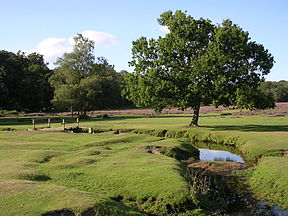TheBeaulieu River(/ˈbjuːli/BEW-lee), formerly known as theRiver Exe,[1]is a small river draining much of the centralNew ForestinHampshire,southernEngland.The riverhas many small upper branchesand its farthest source is 8 miles (13 km) from its 4 miles (6 km)-long tidal estuary. Unusually, the river, including its bed, is owned byLord Montagu of Beaulieu.
| Beaulieu River | |
|---|---|
 The Beaulieu River at Longwater Lawn, near Lyndhurst | |
 | |
| Location | |
| Country | England |
| Region | Hampshire |
| District | New Forest |
| Physical characteristics | |
| Source | |
| • location | Lyndhurst,Hampshire |
| • coordinates | 50°52′47″N1°34′55″W/ 50.879746°N 1.582054°W |
| Mouth | |
• location | Needs Ore Point,Hampshire |
• coordinates | 50°46′16″N1°23′30″W/ 50.770997°N 1.391578°W |
| Length | 20 km (12 mi) |
| Basin features | |
| Tributaries | |
| • left | Beaulieu Abbey Stream |
| • right | Hatchet Stream |
Etymology
editThe current name, Beaulieu isFrench,meaning "beautiful place". The original name, Exe, isBrythonic,deriving from theAncient Britishword *Iskameaning "fishes" or "fish-place" andcognatewith the modern Welsh wordPysg(fishes).This derivation applies to many similarly named rivers throughout Britain including theAxe,ExeandUsk,with the names evolving local distinctions over the centuries.
Course
editThe Beaulieu River rises nearLyndhurstin the centre of the New Forest, a zone where copses and scattered trees interrupt the relatively neutral sandyheathsoil, however with insufficient organic uneroded deposition over millennia to prevent an upper charismaticdendritic drainagebasin of many very small streams. This explains the multitude of tiny headwaters across the New Forest. Many coalesce into the flow southeast and then south across the forest heaths to the village ofBeaulieu.There the river becomestidaland once drove atide millin the village. The mill ceased operations in 1942.[2]Below, the tidal river (estuary) continues to flow south-east through the Forest, passing the hamlet ofBucklers Hardand entering theSolentat Needs Ore. For its final kilometre, it is separated from The Solent by a raised salt marsh known asGull Island.
Below Beaulieu village the river is navigable to small craft. Bucklers Hard was once a significantshipbuildingcentre, building many wooden sailing ships, both merchant and naval, includingNelson'sAgamemnon.Since 2000 the navigable channel at the entrance to the river has been marked by a lighthouse known as the Millennium Lighthouse or the Beaulieu River Beacon.[3][4]
Tributaries
editThe river has two main tributaries, the Beaulieu Abbey Stream to the left and the Hatchet Stream to the right. In addition there are a series of artificial lakes near the mouth of the river, known as the Black Lagoons.
Water quality
editThe Environment Agency measures the water quality of the river systems in England. Each is given an overall ecological status, which may be one of five levels: high, good, moderate, poor and bad. There are several components that are used to determine this, including biological status, which looks at the quantity and varieties ofinvertebrates,angiospermsand fish. Chemical status, which compares the concentrations of various chemicals against known safe concentrations, is rated good or fail.[5]
The water quality of the Beaulieu River was as follows in 2019:
| Section | Ecological Status |
Chemical Status |
Overall Status |
Length | Catchment | Channel |
|---|---|---|---|---|---|---|
| Beaulieu River[6] | Good | Fail | Moderate | 20.0 km (12.4 mi) | 3.075 km2(1.187 sq mi) | Heavily modified |
| Hatchet Stream[7] | Moderate | Fail | Moderate | 7.916 km (4.919 mi) | 9.523 km2(3.677 sq mi) | Heavily modified |
| Beaulieu Abbey Stream[8] | Moderate | Fail | Moderate | 2.535 km (1.575 mi) | 2.253 km2(0.870 sq mi) | Heavily modified |
| Black Lagoons[9] | Good | Fail | Moderate | 0.119 km2(0.046 sq mi) | Artificial |
Film appearances
editThe river was used as a backdrop for some scenes of the 1966 filmA Man for All Seasons– the tree-lined waters were used to portray the 16th centuryRiver Thames.[10]
Gallery
edit-
The infant river upstream from Dunces Arch
-
The river passes beneath the railway, north of Fulliford Passage
-
Bend in the river near Pottern Ford
-
Alder trees in the river north of Fawley Ford
-
The Mill Dam at Beaulieu
-
The upper tidal limit of the river
-
The river between Beaulieu and Bucklers Hard
-
The river at Bucklers Hard
-
A yacht entering the river from the Solent
-
Millennium Lighthouse at the mouth of the river
References
edit- ^Lewis, S. (1848)A Topographical Dictionary of England: Southampton CountyinBritish History Online
- ^Plunkett, David (2014)."Eling and Beaulieu Tide Mills: Restoring and Learning from the Past"(PDF).Hampshire Industrial Archaeology Society.22:26–29.Retrieved3 March2021.
- ^Davison, Steve (2012).Walking in the New Forest: 30 Walks in the New Forest National Park.Cicerone Press Limited. p. 195.ISBN9781849657075.
- ^"60 years in the New Forest".New Forest National Park Authority. Archived fromthe originalon 8 September 2011.Retrieved10 January2013.
- ^"Glossary (see Biological quality element; Chemical status; and Ecological status)".Catchment Data Explorer.Environment Agency. 17 February 2016.Text was copied from this source, which is available under anOpen Government Licence v3.0.© Crown copyright.
- ^"Beaulieu River".Catchment Data Explorer.Environment Agency.
- ^"Hatchet Stream".Catchment Data Explorer.Environment Agency.
- ^"Beaulieu Abbey Stream".Catchment Data Explorer.Environment Agency.
- ^"Black Lagoons".Catchment Data Explorer.Environment Agency.
- ^Gene Brown (1984)The New York Times Encyclopedia of Film: 1964-1968,ISBN0812910532